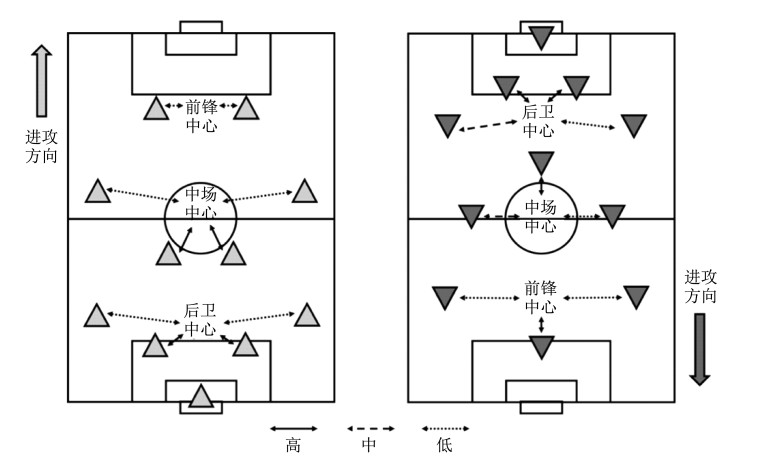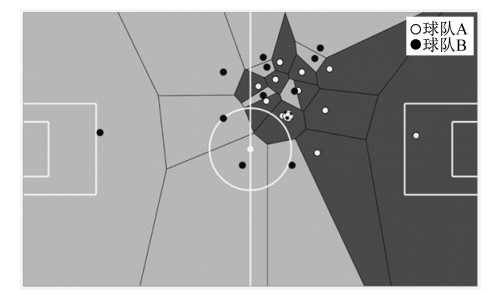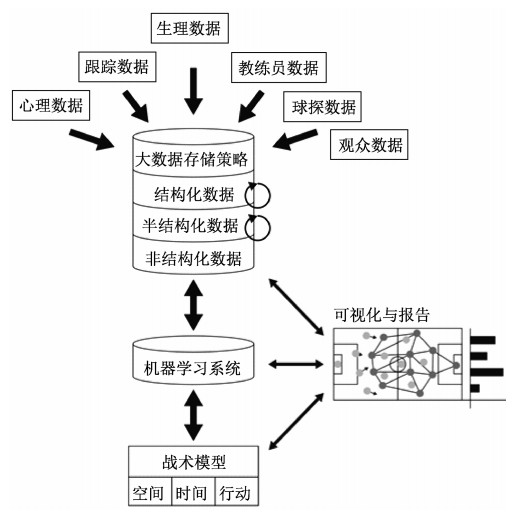Soccer Tactical Analysis Methods and Development Tendency Based on Positional Data Under the Background of Big Data
-
摘要: 对大数据背景下基于位置数据的足球战术分析方法进行分析发现:球队中心法可确定球队几何中心,空间控制法可计算球员所覆盖的区域,网络分析法可测量球队的传球行为,机器学习算法可自动识别球队战术的特征。鉴于大数据技术正在推动足球研究领域的革命,而位置数据只能提供单一空间模式的大数据,未来研究应通过整合关于训练需求、周期负荷、竞赛体系、球员体能和疲劳等信息,将生理、心理、位置、教练员、球探、观众等数据实时压缩成较小的变量,运用数据可视化与报告等手段,为教练员提供客观信息,在某种程度上优化对运动表现结果的预测。大数据技术栈和深度学习技术的AI新方法有望为足球战术研究提供新途径。Abstract: Soccer tactical analysis based on the positional data has shown that the team centroid method can be used to determine the geometric center of the team, space control can calculate individual playing area and dominant region, network analysis can measure the team's pass behavior, and machine learning algorithms can automatically identify the characteristics of team tactics. Given that the big data technology is promoting the study revolution in the field of soccer, the positional data can merely singly provide a spatial pattern analysis value, future research shall integrate varied information including training demands, cycle load, competition system, players' fitness and degree of fatigue. By virtue of processing and compressing data of physiology, psychology, position, coach, scout and audience into smaller variables in real time, coaches can be provided objective information and promote the prediction of performance results to some extent after data visualization and reporting. As a result, the new AI method of big data technology stack and deep learning technology is expected to provide a new approach for the study of soccer tactics.
-
Keywords:
- soccer /
- tactical analysis /
- positional data /
- deep learning /
- big data
-
体育研究以人为对象,具有生动的案例场景和鲜活、独特的样本特征。在体育领域采用案例研究往往聚焦于剖析某一体育组织、体育赛事等案例的过程、特征或路径等。然而,体育案例研究应基于中国体育制度、发展阶段、现实条件和改革壁垒等社会性因素,以及体育教学、科学训练和健康促进等生物性因素的具体情境,构建本土化理论体系。中国体育发展之路为构建本土化体育理论提供了坚实的基础。一方面,扎根中国体育现场作为体育案例研究的新视域。在研究过程中,因体育技能教学、体育赛事组织、训练计划制订、体育组织管理和体育技能评价等具有独特的学科特征,研究者应重视观察、参与、访谈、归纳、提炼和总结等实践性过程。依据案例研究“前因状况—事件·活动·选择—结果事件”的过程理论,采用目的性或理论性抽样的原则,遵循“什么人(Who)”“什么事(What)”“在哪里(Where)”“怎么样(How)”“为什么(Why)”的研究思路,以分析现实困境并与理论对话、综述文献并回顾研究现状、呈现案例并突出具体情境、分析理论并提出理论模型为研究框架,进行探索式或解释性案例分析,可探索运动训练、体育教学、体育管理、体育文化等领域所蕴含的理论。另一方面,构建中国体育理论成为体育案例研究的新目标。理论既是实践发展的指引,也是学术研究的目标。以国外体育或相关领域理论解释中国体育现象,通过训练指标检测评价训练质量,以及就体育社会现象进行表浅分析或成为当前我国体育领域研究的常态。体育案例研究应以学科知识为基础,深入体育教学、运动训练、体育竞赛、全民健身、体育管理等现场,按照“突出情景—展示过程—揭示关系”的分析逻辑,从指导科学系统的运动训练实践中提炼具有推广、示范价值的训练规律和方案,从源远流长的民族体育文化中挖掘体育文化传承、传播和传递的本质属性和路径等。显然,体育案例研究不同于自然和社会学科领域的案例研究,研究者身居其中从体育实践中了解那些不可被量化甚至难以察觉但影响重大的训练、教学、政策等社会性、生物性因素,阐释中国体育发展的历史地位和普遍意义,形成对中国本土体育实践发展具有指导性、推广性、复制性价值的成果。
-
图 1 球队阵型和球员到其位置中心之间距离的可预测性[9]
Figure 1. Team formation and predictability of distances between players and their positional-centroid
图 2 足球比赛情况的泰森多边形图示例[14]
Figure 2. Example of a Voronoi diagram for a typical game situation in soccer
图 3 足球比赛的传递网络(左)和转移网络(右)[6]
Figure 3. A passing network (left) and a transition network (right) in soccer
图 4 足球战术分析的大数据技术栈[3]
Figure 4. Big data technological stack for tactical analysis in soccer
表 1 基于位置数据的战术表现分析的候选表现指标[9]
Table 1 Candidate performance indicators for tactical performance analysis based on position data
关键表现指标 方法 描述 长度、宽度、
空间距离 衡量一支球队在x和y方向上的平均扩张状况,即在2个维度上的平均扩张状况 空间控制 泰森多边形 借助泰森多边形图对空间控制进行建模 事件识别 基于规则、决策树 从位置数据中识别事件,如传球、进球、越位;基于规则的系统 路径聚类 聚类算法 从1名或多名球员的运动模式中筛选小组 传球评估 运动模型和可通过区域 计算区域,如可通过区域基于运动模型的每次传球并根据难度或决策质量评估传球 到球队中心的距离 欧氏度量 计算球员与球队中心的平均、最小和最大距离 阵型 均值、主成分分析 计算平均位置,从而确定一个实际的战术阵型 -
[1] 赵刚, 部义峰, 张丽. 足球运动表现研究进展、问题与趋势[J]. 中国体育科技, 2014, 50(4): 25-32 doi: 10.3969/j.issn.1002-9826.2014.04.004 [2] 赵刚, 陈超. 足球比赛表现研究方法和评价指标体系研究[J]. 体育科学, 2015, 35(4): 72-81 https://www.cnki.com.cn/Article/CJFDTOTAL-TYKX201504009.htm [3] MEMMERT D, RAABE D. Data analytics in football: Positional data collection, modelling and analysis[M]. London and New York: Routledge, 2018: 170
[4] LOW B, COUTINHO D, GONÇALVES B, et al. A systematic review of collective tactical behaviours in football using positional data[J]. Sports Medicine, 2020, 50(2): 343-385 doi: 10.1007/s40279-019-01194-7
[5] MACKENZIE R, CUSHION C. Performance analysis in football: A critical review and implications for future research[J]. Journal of Sports Sciences, 2013, 31(6): 639-676 doi: 10.1080/02640414.2012.746720
[6] GUDMUNDSSON J, HORTON M. Spatio-temporal analysis of team sports[J/OL]. ACM Computing Surveys, 2017, 50(2): 1-34[2021-03-01]. https.//doi.org/10.1145/3054132
[7] SARMENTO H, MARCELINO R, ANGUERA M T, et al. Match analysis in football: A systematic review[J]. Journal of Sports Sciences, 2014, 32(20): 1831-1843 doi: 10.1080/02640414.2014.898852
[8] DUTT-MAZUMDER A, BUTTON C, ROBINS A, et al. Neural network modelling and dynamical system theory: Are they relevant to study the governing dynamics of association football players?[J]. Sports Medicine (Auckland, N.Z. ), 2011, 41(12): 1003-1017 doi: 10.2165/11593950-000000000-00000
[9] MEMMERT D, LEMMINK K A P M, SAMPAIO J. Current approaches to tactical performance analyses in soccer using position data[J]. Sports Medicine, 2017, 47(1): 1-10 doi: 10.1007/s40279-016-0562-5
[10] 雷辉, 劳天溢, 刘真, 等. 体育数据可视化综述[J]. 计算机辅助设计与图形学学报, 2015, 27(9): 1605-1616 doi: 10.3969/j.issn.1003-9775.2015.09.003 [11] PERIN C, VUILLEMOT R, STOLPER C D, et al. State of the art of sports data visualization[J]. Computer Graphics Forum, 2018, 37(3): 663-686 doi: 10.1111/cgf.13447
[12] REIN R, MEMMERT D. Big data and tactical analysis in elite soccer: Future challenges and opportunities for sports science[J]. SpringerPlus, 2016, 5(1): 1410 doi: 10.1186/s40064-016-3108-2
[13] GONÇALVES B V, FIGUEIRA B E, MAÇÃS V, et al. Effect of player position on movement behaviour, physical and physiological performances during an 11-a-side football game[J]. Journal of Sports Sciences, 2014, 32(2): 191-199 doi: 10.1080/02640414.2013.816761
[14] REIN R, RAABE D, MEMMERT D. "Which pass is better?" Novel approaches to assess passing effectiveness in elite soccer[J]. Human Movement Science, 2017, 55: 172-181 doi: 10.1016/j.humov.2017.07.010
[15] BREFELD U, LASEK J, MAIR S. Probabilistic movement models and zones of control[J]. Machine Learning, 2019, 108(1): 127-147 doi: 10.1007/s10994-018-5725-1
[16] TAKI T, HASEGAWA J. Visualization of dominant region in team games and its application to teamwork analysis[C]//Proceedings of the International Conference on Computer Graphics(CGI). Geneva, 2000: 227-235
[17] FUJIMURA A, SUGIHARA K. Geometric analysis and quantitative evaluation of sport teamwork[J]. Systems and Computers in Japan, 2005, 36(6): 49-58 doi: 10.1002/scj.20254
[18] GUDMUNDSSON J, WOLLE T. Football analysis using spatio-temporal tools[J]. Computers, Environment and Urban Systems, 2014, 47: 16-27 doi: 10.1016/j.compenvurbsys.2013.09.004
[19] PASSOS P, DAVIDS K, ARAÚJO D, et al. Networks as a novel tool for studying team ball sports as complex social systems[J]. Journal of Science and Medicine in Sport, 2011, 14(2): 170-176 doi: 10.1016/j.jsams.2010.10.459
[20] GRUND T U. Network structure and team performance: The case of English Premier League soccer teams[J]. Social Networks, 2012, 34(4): 682-690 doi: 10.1016/j.socnet.2012.08.004
[21] CLEMENTE F M, MARTINS F M L, WONG P D, et al. Midfielder as the prominent participant in the building attack: A network analysis of national teams in FIFA World Cup 2014[J]. International Journal of Performance Analysis in Sport, 2015, 15(2): 704-722 doi: 10.1080/24748668.2015.11868825
[22] CLEMENTE F M, SILVA F, MARTINS F M L, et al. Performance analysis tool for network analysis on team sports: A case study of FIFA Soccer World Cup 2014[J]. Proceedings of the Institution of Mechanical Engineers, Part P: Journal of Sports Engineering and Technology, 2016, 230(3): 158-170 doi: 10.1177/1754337115597335
[23] CLEMENTE F M, MARTINS F M L, MENDES R S. Analysis of scored and conceded goals by a football team throughout a season: A network analysis[J]. Kinesiology, 2016, 48(1): 103-114 doi: 10.26582/k.48.1.5
[24] PEÑA J L, TOUCHETTE H. A network theory analysis of football strategies[C]//Proceedings of 2012 Euromech Physics of Sports Conference. Paris, 2012: 517-528
[25] HORTON M, GUDMUNDSSON J, CHAWLA S, et al. Automated classification of passing in football[C]//Proceedings of the Advances in Knowledge Discovery and Data Mining-19th Pacific-Asia Conference (PAKDD). Ho Chi Minh City, 2015: 319-330
[26] BIALKOWSKI A, LUCEY P, CARR P, et al. Large-scale analysis of soccer matches using spatiotemporal tracking data[C]//Proceedings of the 2014 IEEE International Conference on Data Mining(ICDM). Shenzhen, 2014: 725-730
[27] KNAUF K, MEMMERT D, BREFELD U. Spatiotemporal convolution kernels[J]. Machine Learning, 2016, 102(2): 247-273 doi: 10.1007/s10994-015-5520-1
[28] HIRANO S, TSUMOTO S. Grouping of soccer game records by multiscale comparison technique and rough clustering[C]//5th International Conference on Hybrid Intelligent Systems(HIS). Rio de Janeiro, 2005: 399-404
[29] FERNANDO T, WEI X, FOOKES C, et al. Discovering methods of scoring in soccer using tracking data[C]//Proceedings of the KDD workshop on large-scale sports analytics. Sydney, NSW, 2015: 1-4
[30] MONTOLIU R, MARTÍN-FÉLEZ R, TORRES-SOSPEDRA J, et al. Team activity recognition in association football using a bag-of-words-based method[J]. Human Movement Science, 2015(41): 165-178 http://www.onacademic.com/detail/journal_1000037777006010_a3f5.html
[31] WANG Q, ZHU H S, HU W, et al. Discerning tactical patterns for professional soccer teams: An enhanced topic model with applications[C]//Proceedings of the 21th ACM SIGKDD International Conference on Knowledge Discovery and Data Mining(KDD). Sydney, NSW, 2015: 2197-2206
[32] 程学旗, 靳小龙, 王元卓, 等. 大数据系统和分析技术综述[J]. 软件学报, 2014, 25(9): 1889-1908 https://www.cnki.com.cn/Article/CJFDTOTAL-RJXB201409002.htm [33] 杨春然. 论大数据模式下运动员隐私的保护[J]. 体育科学, 2018, 38(2): 82-90 https://www.cnki.com.cn/Article/CJFDTOTAL-TYKX201802008.htm [34] LECUN Y, BENGIO Y, HINTON G. Deep learning[J]. Nature, 2015, 521(7553): 436-444 doi: 10.1038/nature14539
[35] CUST E E, SWEETING A J, BALL K, et al. Machine and deep learning for sport-specific movement recognition: A systematic review of model development and performance[J]. Journal of Sports Sciences, 2019, 37(5): 568-600 doi: 10.1080/02640414.2018.1521769
[36] LE H M, CARR P, YUE Y, et al. Data-driven ghosting using deep imitation learning[C]//MIT Sloan Sports Analytics Conference(SSAC). Boston, 2017: 1-15
[37] MNIH V, KAVUKCUOGLU K, SILVER D, et al. Humanlevel control through deep reinforcement learning[J]. Nature, 2015, 518(7540): 529-533 doi: 10.1038/nature14236
[38] SILVER D, HUANG A, MADDISON C J, et al. Mastering the game of go with deep neural networks and tree search[J]. Nature, 2016, 529(7587): 484-489 doi: 10.1038/nature16961
[39] LE H M, YUE Y, CARR P, et al. Coordinated multi-agent imitation learning[C]//Proceedings of the 34th International Conference on Machine Learning(ICML). Sydney, NSW, 2017: 1995-2003
[40] SUTTON R S, BARTO A G. Reinforcement learning: An introduction[M]. Cambridge: Massachusetts Institute of Technology Press, 2018: 1-22
[41] DICK U, BREFELD U. Learning to rate player positioning in soccer[J]. Big Data, 2019, 7(1): 71-82 doi: 10.1089/big.2018.0054
[42] FERNANDEZ J, BORNN L, CERVONE D. Decomposing the immeasurable sport: A deep learning expected possession value framework for soccer[C]//MIT Sloan Sports Analytics Conference(SSAC). Boston, 2019: 1-20
[43] FERNANDEZ J, BORNN L. Wide open spaces: A statistical technique for measuring space creation in professional soccer[C]//MIT Sloan Sports Analytics Conference(SSAC). Boston, 2018: 1-19
-
期刊类型引用(3)
1. 柳鸣毅,敬艳,孔年欣,尹子康,蔡静洁,彭李奥,郭成根. 体育案例研究的学理基础、基本要素与中国探索. 首都体育学院学报. 2024(01): 12-21 .  百度学术
百度学术
2. 刘娟. 大学生体育核心素养数字化评价的内在价值、阻滞因素与应对策略. 吉林体育学院学报. 2024(03): 78-84 .  百度学术
百度学术
3. 姬爱冬,焦润艺,董德河,韩松岩,宋雅芳,白东艳. 传统阴阳丹法养生术在鼓励生育背景下的医学伦理重塑及教学策略. 武当. 2023(06): 54-57 .  百度学术
百度学术
其他类型引用(3)





 下载:
下载:


